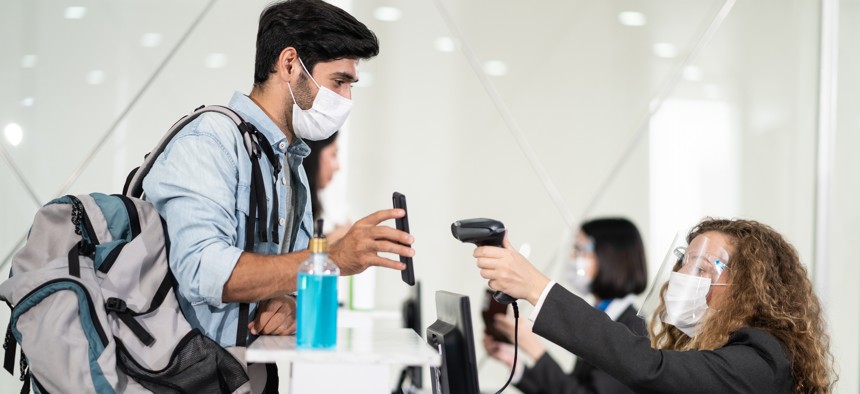
Kiwis/Getty
TSA Wants to Automate ID Verification at Checkpoint Security
The agency is testing using facial recognition to verify passengers’ information with the information on record.
The Transportation Security Administration, or TSA, is adding digital IDs to a pilot program for testing facial recognition technology at airports across the country as part of its evaluation of the effectiveness of this technology as the agency works to further digitize and automate passenger identity verification at checkpoint security.
Passenger ID verification is traditionally done by presenting a physical ID to a TSA agent who checks that against the traveler’s flight and biographical information stored in the agency’s database. The agency is exploring if it can use digital IDs––which are digital versions of the information on a physical ID that is stored and accessed on a mobile device, such as a mobile driver’s license––checked against a real-time facial recognition scan for the verification process.
TSA is using the Credential Authentication Technology 2, or CAT-2, system identity verification at 16 airports, according to a Washington Post article. It will collect and compare the information from the digital ID––the photograph and personally identifiable information––with the passenger’s live photo and flight information. TSA previously tried this with physical IDs and is now seeing if this is possible with digital IDs.
TSA began the pilot in early 2022 in an effort to “support the phased rollout of digital IDs, including mobile driver’s licenses.” During the beginning of the rollout process, TSA will only accept select mobile driver’s licenses and digital IDs from TSA PreCheck passengers. Non-TSA PreCheck passengers will be able to use a mobile driver’s license in the future.
“TSA expects that facial verification may permit TSA personnel to improve airport security and expedite checkpoint security processes,” the agency’s Privacy Impact Assessment said.
An individual can tap their mobile device against the CAT-2 digital reader or scan the QR code shown on their phone screen. The individual will then see the information being shared with TSA and must consent to share this information.
The individual’s information is verified by authenticating the digital ID, matching the digital ID information and photo against flight booking information and the live photo of the individual taken by the facial recognition scanner. Upon verification, the passenger will be able to proceed through the checkpoint. A TSA officer will be present throughout the verification process.
According to the agency, it will anonymize and encrypt the collected data and transfer it for temporary analysis to the Homeland Security Department Science and Technology Directorate to assess the effectiveness of this technology at the TSA checkpoint. TSA will delete the data within two years.
TSA noted that when it is not conducting the evaluation, passengers’ live photos and personally identifiable information from their digital ID will only last until the next passenger is scanned, when the system overwrites the old passenger’s information with the newest passenger’s information.
Individuals are allowed to opt-in to this voluntary pilot program, where TSA will collect the aforementioned information “for the purposes of enhancing transportation security, identity verification, and testing the effectiveness of this technology at the checkpoint under the authority of the Aviation and Transportation Security Act.” According to TSA, it may share a passenger’s provided information with DHS S&T, law enforcement, intelligence agencies and others.
If a passenger does not opt-in, they will go through the standard checkpoint screening process.







